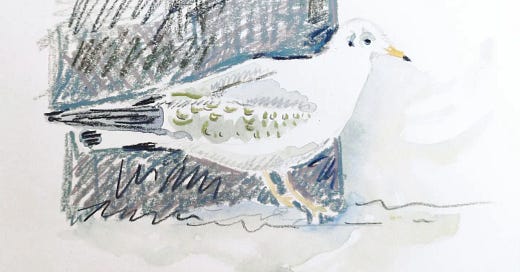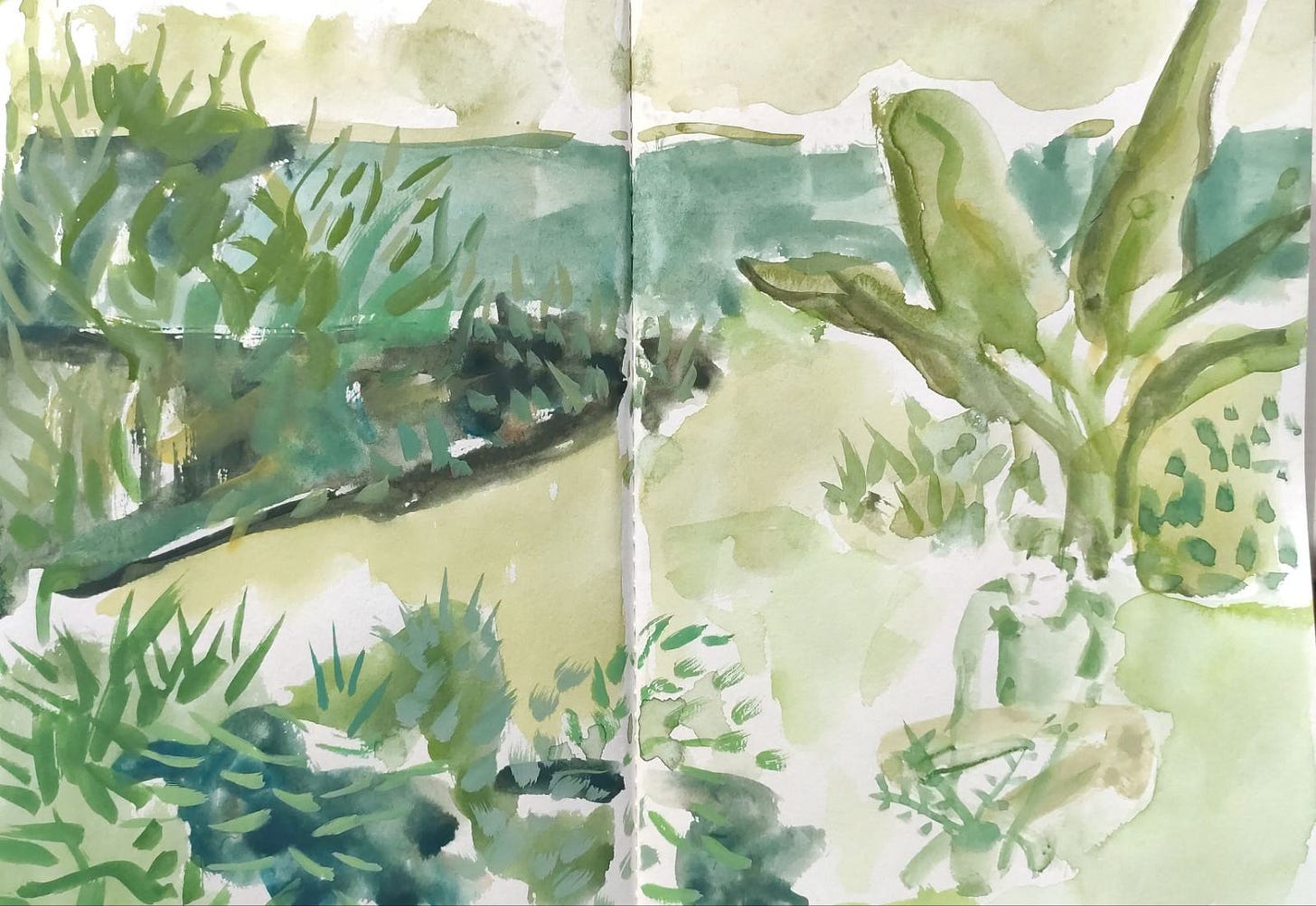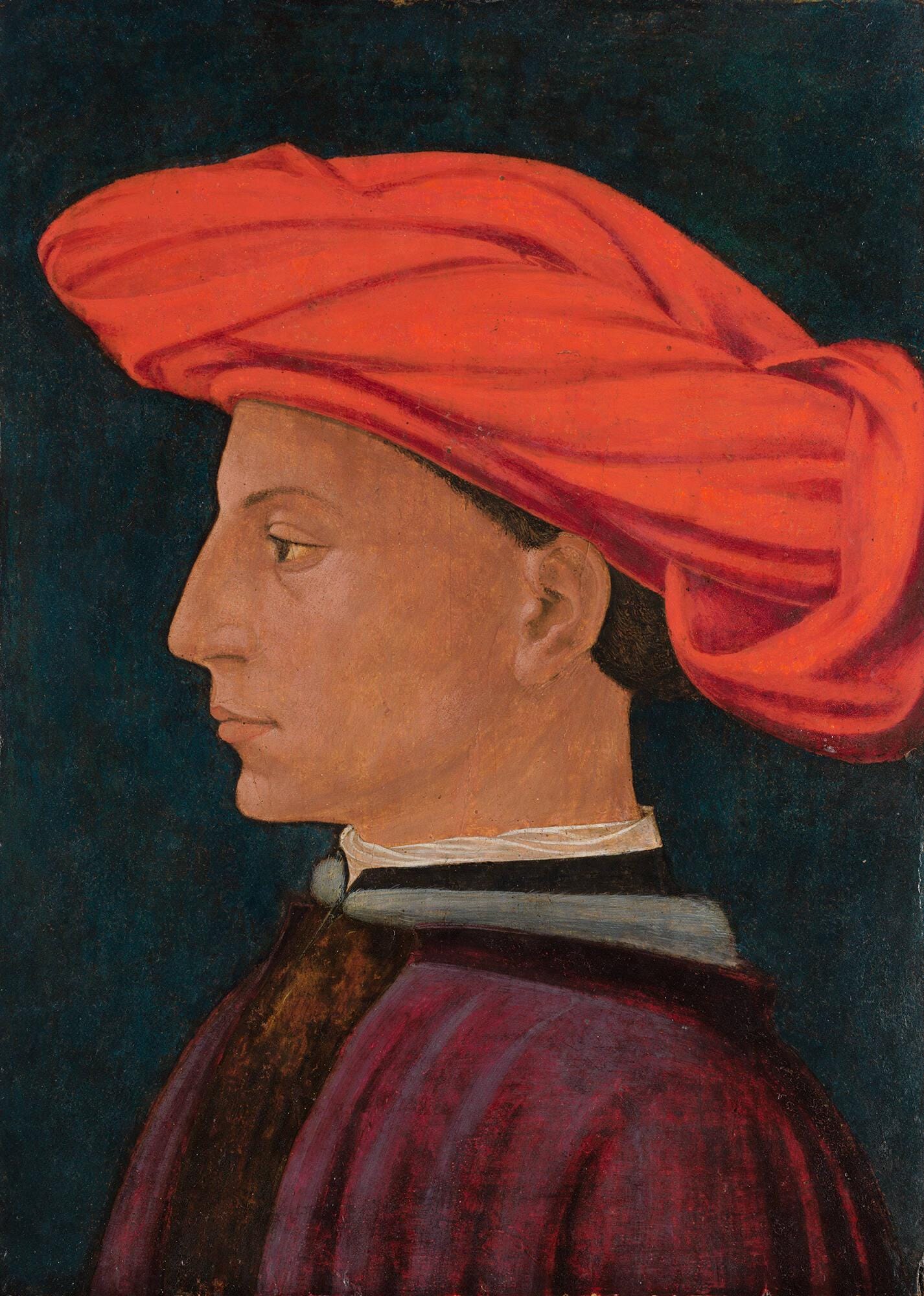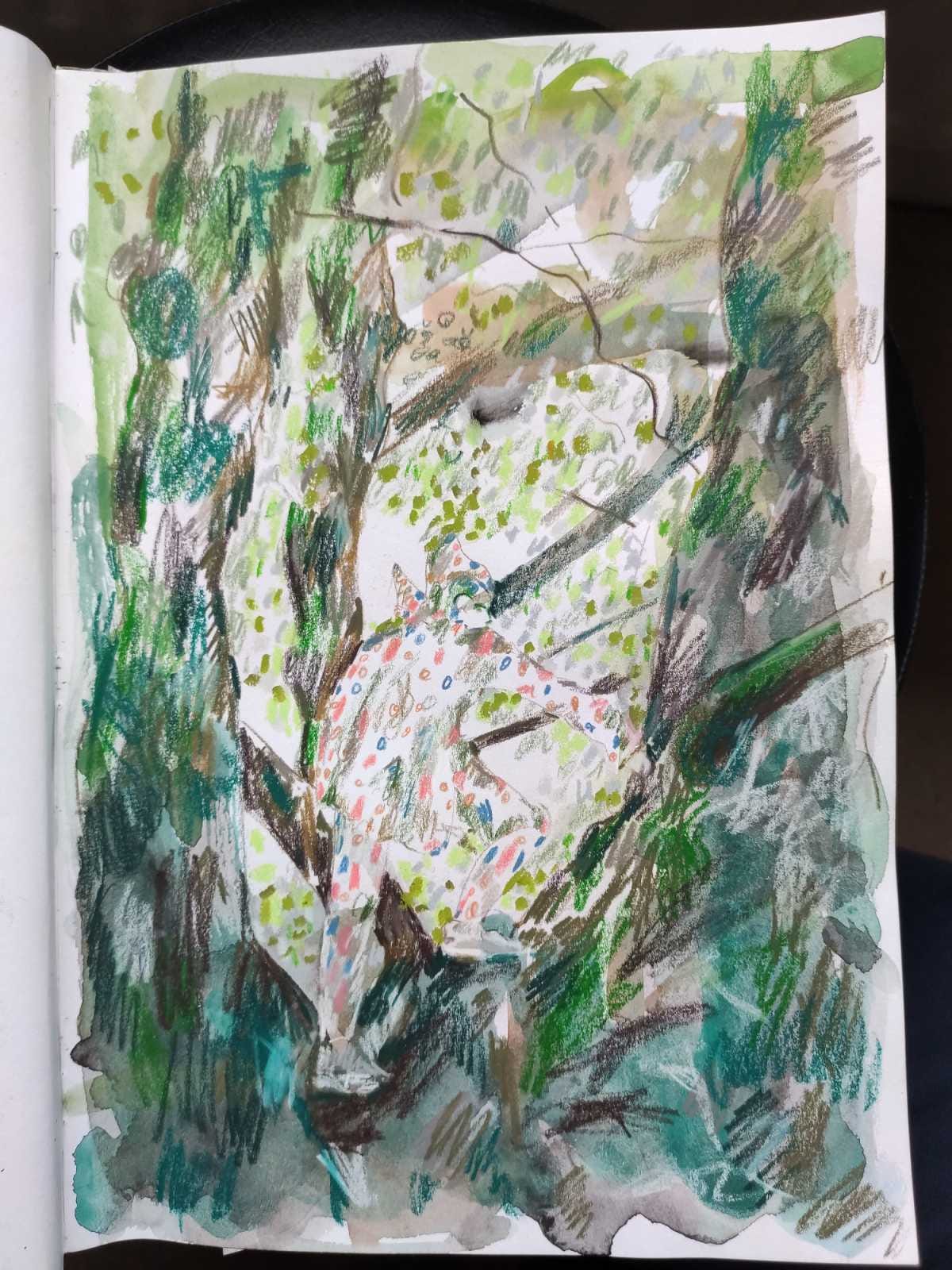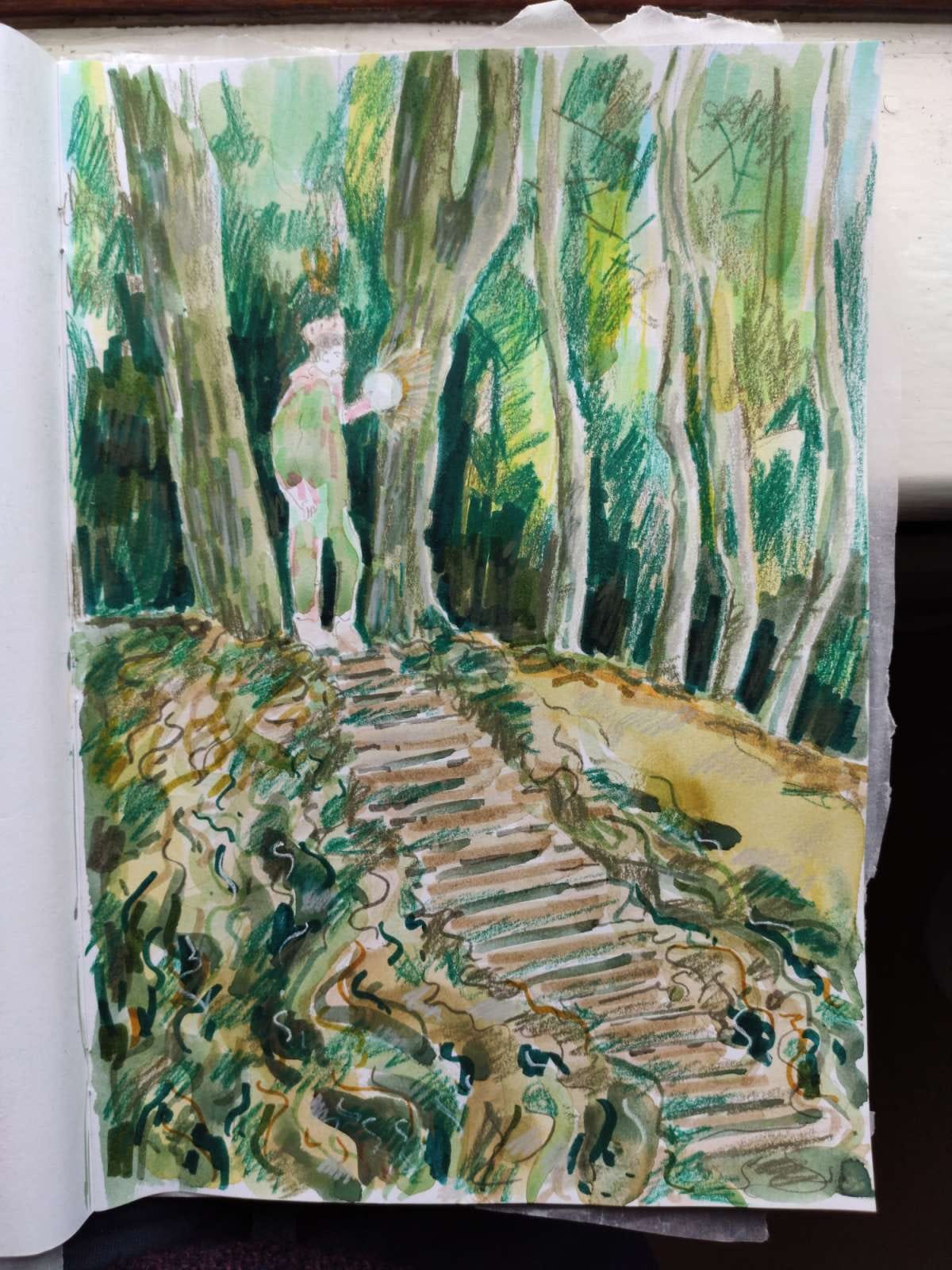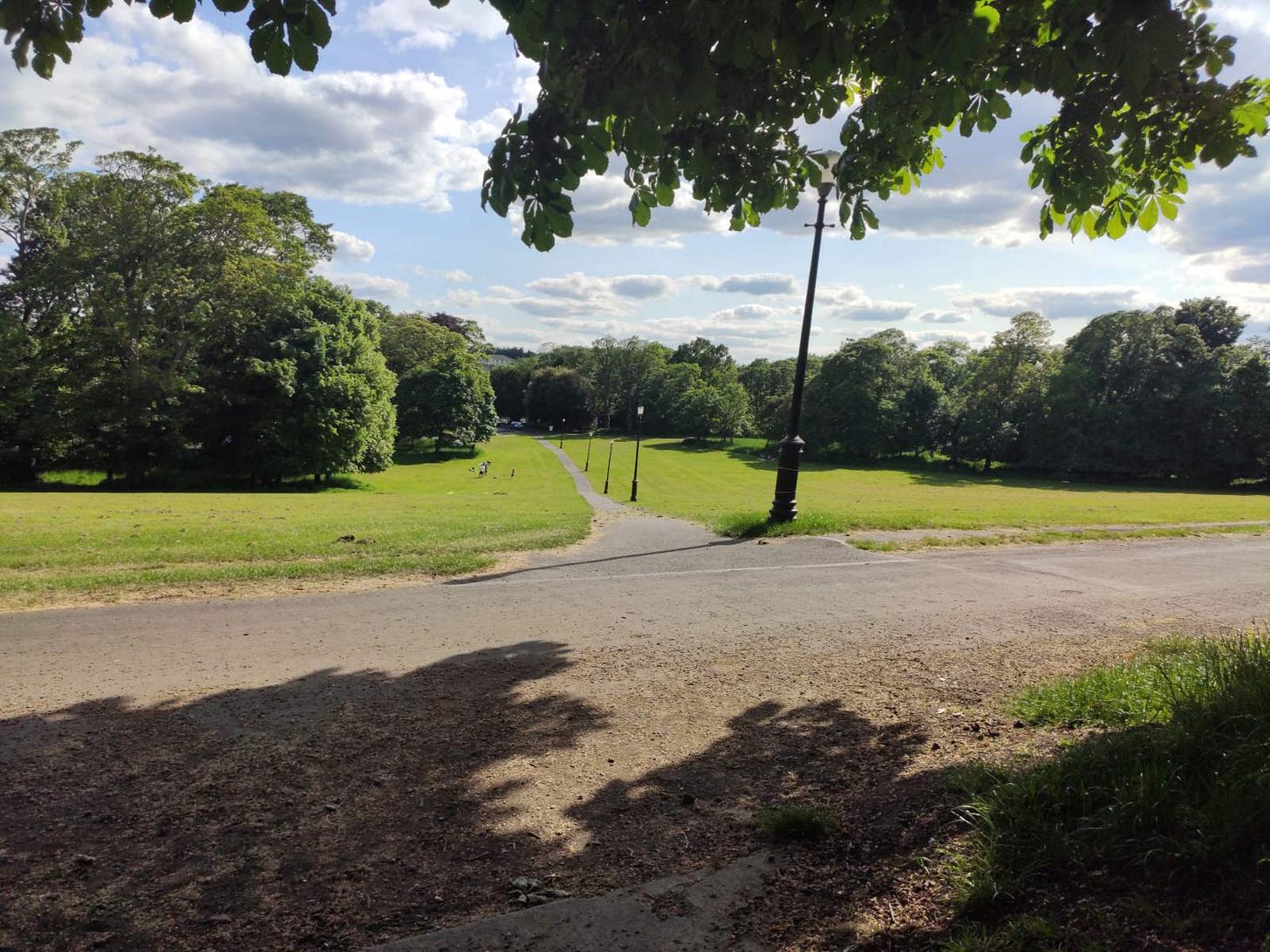June Letter
On birdsong, "drawing" in paint, new terrain, "narrative" pictures, the Isabella Stewart Gardner Museum, and Massacio's "Young Man in a Scarlet Turban."
I
Art Adjacent: Birdsong
Hello once again,
One thing I love about where I live (although I don’t love everything) is that I am, as with my old house, surrounded by birdsong, most particularly in the last few weeks.
And in a couple of years defined by profound change it is nice to have this little through-line for the moment at least. The gardens where I live are quite long and bordered by hedges and trees and so I wake each morning to the sounds of birds. And again, as with my old house, I see doves and pigeons courting on the walls and lawn, see robins and blackbirds in the hedges, jackdaws and magpies on the lawn. Only occasionally, when the grey Persian two doors down slopes past, is there a lull.
And this morning, alighting briefly on the kitchen roof, I saw a grey-brown dove (or pigeon) I’d never seen before, or at least never in my old garden.
And so I am choosing to be optimistic, based on the principle, as in the wild, that only good places attract birds, and allow for birdsong.
II
Process Notes: “Drawing” in Gouache Paint
Last month I was focused on figure drawing and this month I am continuing to focus on that subject, more or less, although in other media.
I mentioned last time that I was also focusing specifically on gouache figure drawing (or painting) last month and that was a deliberate choice. In the past I have used gouache mostly in the context of mixed media pieces, whether in my sketchbooks, or in original pieces on paper, but last month I wanted to see what I could produce without leaning on dry media.
In the past I would often finish off a piece with dry media and presume that I would be able to add a dimension of precision and texture that mightn’t exist otherwise with various dry media like colouring pencils, artist grade crayons or markers. But last month I wanted to try and see how far I could push against my limitations and attempt to produce all the effects I might want just with paint alone, or at the very least, lean into the more painterly effects, and accept them, even if it meant there was a looser and rawer aspect to the pictures I produced.
And I will say that the pieces I produced were often rawer and looser than I am used to but fortunately I have always enjoyed those aspects to other artists and found myself more willing than I expected to embrace those qualities in my own work.
And although I have feared this aspect of painting there is something compulsive (like off-course and acrobatic calligraphy) about “drawing” with a brush. There isn’t the same precision (or at least not yet) you might achieve with a pen or pencil but there is something expressive I am liking more and more. In fact, when I moved back to drawing after this phase I felt the limits of the pencil in a new way and realised that in certain respects a brush is a more forgiving instrument!
III
Art Objects: “Young Man with a Scarlet Turban”
“Young Man with a Scarlet Turban” attrib: Masaccio (Castl San Giovanni), 1401-1428, Rome.
This month I want to do something a little different – read a piece of work against and in its context. In fact, in this instance I am probably in some ways at least as interested in this piece’s physical context as I am in it as a work of art in itself.
This painting - “Young Man with a Scarlet Turban” by Masaccio - can be found in the Isabella Stewart Gardner Museum in Boston, and in some ways, just as the collection of poems an individual poem appears in can subtly or unsubtly affect its meaning I think a painting’s “aura” or presence can be hugely affected by the room and museum it is housed in.
And what a museum the Isabella Gardner is! I first visited it some years ago and was taken aback at its uniqueness. What you have is a carefully curated imitation Venetian palace filled with works of art, each deliberately presented in manners chosen to express the particular virtues of each piece. Born out of an Italophile dream to have a house filled with beautiful pictures the museum now presents as an extravagant and elegant private collection opened to the public. Or at least that is the conceit underlying every visit.
And so in this museum there is an intimacy borne out of knowing that this painting is deliberately placed opposite this mirror or at the foot of that staircase or in one of the specially arranged rooms, with furniture and wallpaper to match, or other art objects, ornaments or sculptures near at hand. And this design gives each piece the most specific and personalised “setting” it might possibly have – in many ways, to my mind, this is perhaps the ideal approach for any museum.
Massacio’s painting is placed in the “Early Italian Room” of the museum amidst sympathetic furniture (an C18th painted walnut chair), ornaments (bronze bear sculptures from between about 260 BC – 9CE) and Gothic and Renaissance art and to give you a notion of how carefully and uniquely curated every aspect of the museum is, here is a sample from the painting’s online “object description”:
“This vertical tempera on panel painting shows a light-medium-skinned young man in profile, looking to our left. He has short bark brown hair and a large, straight nose with a neutral expression on his face. The scarlet turban on his head is intricately wrapped and voluptuous. He has a dark red and purple robe over a black shirt with a white collar and a light blue scarf around his lower neck. The background is very dark teal blue. Painting rests in a grooved, slightly gilded frame.”
To me this is beautiful, a little loving prose-poem all by itself, and emblematic of the whole museum’s approach to its artefacts.
And this consideration is carried forward to how the painting is displayed. The affect of the painting as the enter the room is notable: the bright neon sign of ancient, slightly time-worn scarlet it represents in the corner of your eye is potent. You are stopped in your tracks by it, re-directed towards it. It has that magnetism.
Portraits have a unique power. It is no accident that the Mona Lisa is one of the most famous paintings in the world. And even this lesser-known portrait has its allure, much of it to do with the questions that circulate around most old portraits: who was this sitter? What was their life? Why were they chosen as notable? And why are they presented thus, in this costume, at this angle, in this light?
And of course the greatest question regarding this portrait relates to the titular turban. Why this extravagance and emphasis? It is in its way as emblematic of the portrait’s mystery as the Mona Lisa’s smile.
“It is intricately wrapped and voluptuous” the object description informs us. And I like to think of that intricacy as the centre of the painting’s great puzzle. It is a great knot we tug at every time we look, but it continues to hold its secrets.
IV
Art Process: Narrative Print Category
I have added a new section to my website art store, “Narrative Prints”. I wrote a fairly lengthy post on this when I added the first piece to this section. For me creating narrative pictures feels like the something to aspire towards as it is so complex and incorporates many elements: landscape, portrait, still life, architectural drawing. All of the “representational” disciplines.
I also, for those who want to take a look at the constantly evolving website store, divided up my landscape section. There is now a separate section for “Weir Studies” as I felt there were so many “riverscapes” featured that they deserved their own section!
V
Art Adjacent II: New Terrain
In the last house I lived in late last year I drew and painted a river.
Well a weir, specifically. And it was a genuine inspiration. We lived right beside it. From our sitting room we could hear the water day after day in a gentle undertone. It was very beautiful.
And in this house, locked more in suburbia now, (but with a garden filled with birdsong just the same) I realise I have been searching for new terrain. A new and unique and specific locale to focus on, amongst the other artistic mini-projects I have going on.
And I think my sense of a new artistic terrain has evolved from occasional walks that I have taken in the Phoenix Park, most particularly the wilder end, away from the city. There are herds of deer there, and little hidden lakes, and high trees (the sort you don’t normally see) and winding woods paths leading back on themselves in loops and curves.
Needless to say, hothouses and botanic gardens and the like shall remain my central obsession (in terms of environments to draw and paint) but for now, while I live in this house, this great park, the biggest in Europe, is evolving into my new terrain.
VI
A reminder to check out my website shop at davidmonteiroart.com. Or follow the link in my instagram bio. I have a good number of prints available – some landscape, some botanic, a small few focused on animals and birds. Details of my printer supplier is featured with each listing.
UK and EU deliveries are custom free.
Also please do check out the small (but slowly increasing) collection of originals I’ve been adding to my website store over the last few weeks.
And if you are interested in pictures not currently listed I can add them to the store and you will receive them at the same rates as the ones already listed.
VII
This newsletter will continue on a monthly basis.
In the meantime if you are reading regularly I would ask that you would please consider subscribing to this monthly newsletter and if you would also consider buying me a coffee on Ko-fi at this link (https://ko-fi.com/davidmonteiro) it would be much appreciated so I can evolve and develop my practise. Many thanks.

